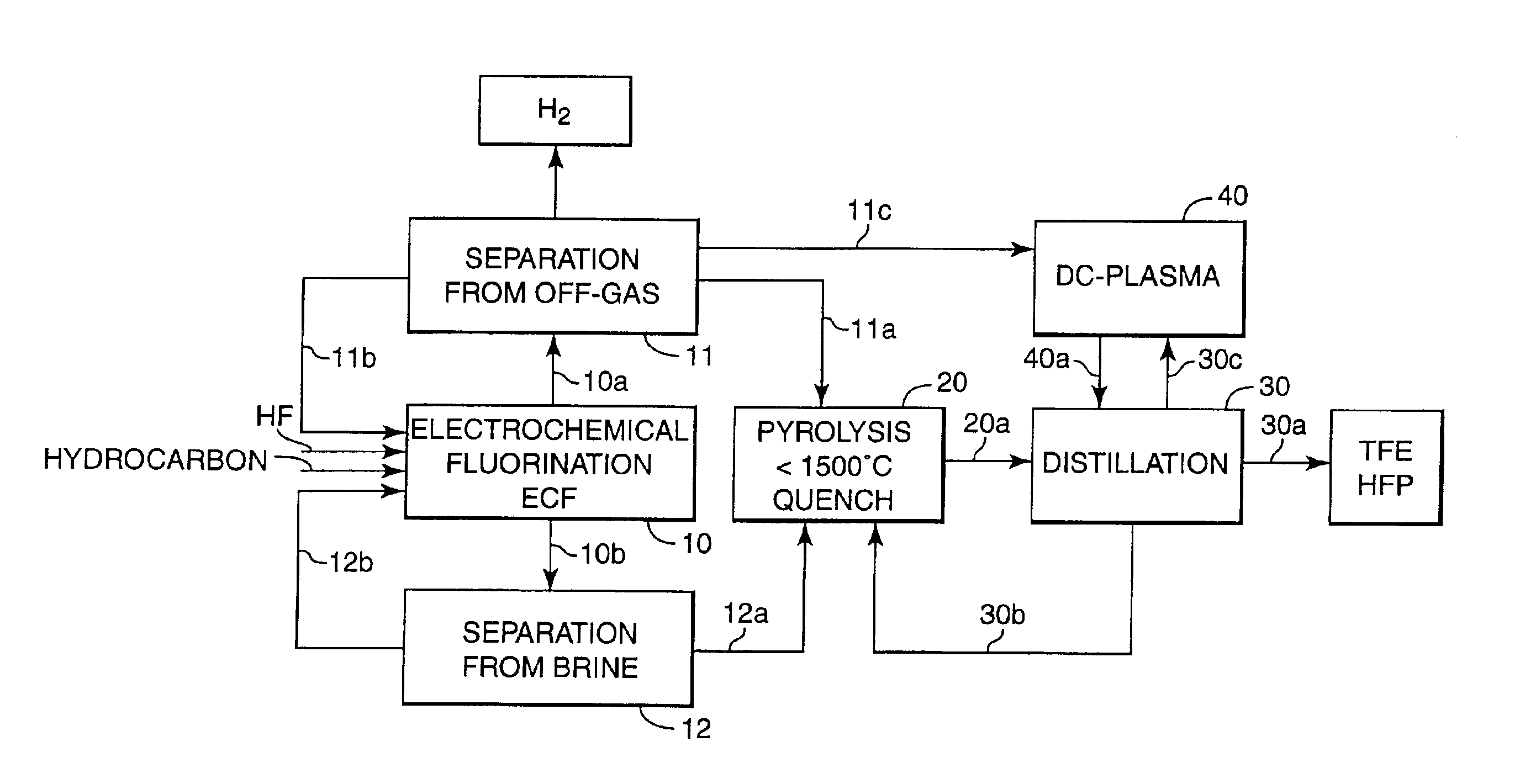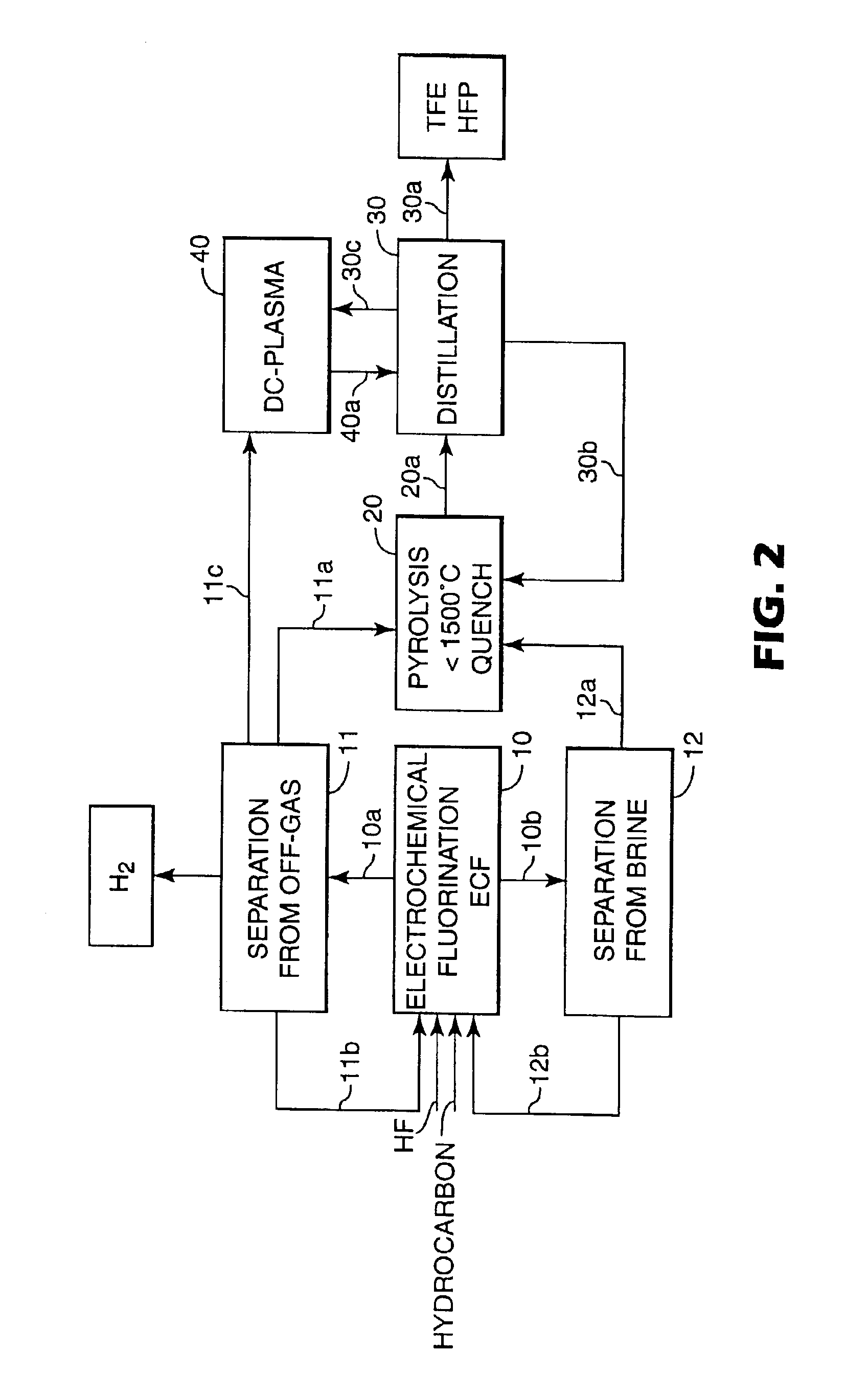Process for manufacturing fluoroolefins
a technology of fluoroolefins and manufacturing processes, applied in the field of manufacturing fluoroolefins, can solve the problems of difficult separation, low economic viability of the process, and high amount of cosub>2, and achieve the effects of less separation efforts, efficient yield and elimination of hydrochloric acid waste streams
- Summary
- Abstract
- Description
- Claims
- Application Information
AI Technical Summary
Benefits of technology
Problems solved by technology
Method used
Image
Examples
example 1
Simons Electrochemical Fluorination of Octane
[0064]A 1-liter electrochemical fluorination cell of the type described in U.S. Pat. No. 2,567,011, equipped with 2 overhead condensers having a nickel anode with a surface area of 0.037 m2 was charged with 1000 grams C6F14, 40 grams of dimethyldisulfide, 40 grams of octane and 200 grams of anhydrous HF. The cell was operated at 45° C. and 2 bar. Voltage was between 5-6 Volts, current density about 1500 A / m2. Voltage was reduced for 4 seconds to less than 4 Volts causing the current to fall to essentially zero after each 80 seconds (“intermitted current”). Octane was continuously fed to the cell to maintain its concentration in the circulating fluorochemical phase at about 5 wt %. Circulation rate was varied from 0.3 to 1 cell volume / hour with an external pump without an observably distinct effect on the fluorination rates.
[0065]The experiment was run for 500 hours. Intermittently, a portion of the fluorochemical phase was removed, the pe...
example 2
Membrane Process
[0067]The off-gas stream emanating from the ECF cell behind the overhead condensers at the run of Example 1 contained about 1.7 volume % of perfluorinated alkanes. Typical composition is shown in Table 1.
[0068]
TABLE 1Composition of off-gas; balance H2ComponentsCF4C2F6C3F8C4F10C3F12CHF3TotalVolume %0.250.420.20.440.20.11.61
The off-gas stream was washed with aqueous NaOH solution, filtered to remove any liquid and solid particles compressed to 8 bar and fed to a 2-stage membrane system consisting of a polyimide, asymmetric composite hollow fiber membrane. A MEDAL™ Gas separation process from Air Liquide, Houston, Tex., according to Example 4 of U.S. Pat. No. 5,814.127 was used. The output of the 2nd membrane module yielded 99.9% fluorocarbon with less than 0.1% H2, the composition of which is given in Table 2. The “waste-stream” contained 99.7% hydrogen. The recovered fluorocarbons can be directly used as carrier gas at the DC plasma pyrolysis and also as feedstock for...
example 3
Preparation of TFE Via DC-plasma Pyrolysis
[0070]A 30 kW DC plasma torch was used as described in WO 01 / 58841. Presence of carbon was given by “self-consuming” carbon electrodes. Dry quenching was used. The efficiency of this method is illustrated with pure fluorocarbons (Table 3) and the fluorocarbon mixture from the off-gas of Example 2 (Table 4). The carrier gas used was CF4. The CF4 stream was fed through a vaporizer containing the investigated fluorocarbons. Flow rate was varied from about 3.5 to 7.5 kg / hr. Results are shown in Table 3.
[0071]
TABLE 3DC plasma pyrolysis of selected fluorocarbonsPerfluorinatedFeed RateFlow Rate kg / hrFeedkg / hrof quenched reaction mixtureotherStock*FeedCF4CF4C2F4C3F6FC'sC8F18 (FC 3225)0.453.01.71.20.150.4C7F16 (PF 5070)1.704.94.21.70.10.6C7F16 (PF 5070)1.533.02.41.30.00.8C6F14 (PF 5060)2.864.03.52.40.40.6C5F12 (PF 5050)4.403.03.73.70.0*The Perfluorinated Feed Stock is available from 3M Company, St. Paul, MN. HFP was produced with very low yields.
Tab...
PUM
| Property | Measurement | Unit |
|---|---|---|
| boiling point | aaaaa | aaaaa |
| temperature | aaaaa | aaaaa |
| temperature | aaaaa | aaaaa |
Abstract
Description
Claims
Application Information
 Login to View More
Login to View More - R&D
- Intellectual Property
- Life Sciences
- Materials
- Tech Scout
- Unparalleled Data Quality
- Higher Quality Content
- 60% Fewer Hallucinations
Browse by: Latest US Patents, China's latest patents, Technical Efficacy Thesaurus, Application Domain, Technology Topic, Popular Technical Reports.
© 2025 PatSnap. All rights reserved.Legal|Privacy policy|Modern Slavery Act Transparency Statement|Sitemap|About US| Contact US: help@patsnap.com



